Nutshell summary
This article combines a model of self-control with a model of temptation to better understand why temptation is so hard to avoid.
Of the three regions that surround an object of temptation, the danger zone is the one that trips you up – because it feels kind of like the safe zone.
While you are in the danger zone, you still have self-control.
However, staying in the danger zone requires exerting active resistance to temptation at an unsustainable rate.
So, even while standing still in the danger zone – while “doing nothing” – the akratic zone expands toward you.
If you stand there long enough, the akratic zone will envelop you.
For example, you may initially be safe five feet from the cookie jar, but if you stay at that distance, it’s just a matter of time before you get up and grab one.
For some background on willpower, my article on self-control discusses akrasia and contains a model of will (as the product of willpower and willenergy) derived largerly from Baumeister’s research.
Baumeister reviews this work at length in Willpower:

Temptation is a field
If you have ever walked through the kitchen and found your hand unconsciously plunging into the cookie jar as you walk by, you have experienced being sucked into a temptation field.
It may not have been in your conscious plan to grab a cookie, but once you came close, you grabbed one.
(If you pay close attention, you may even find that your hand grabbed it without you consciously directing it to!)
Physics uses fields to model and predict phenomena like gravity and electromagnetism that vary with space and time.
A field can also model and predict your behavior with respect to temptation.
In a gravitational field, the attractive force varies with distance to a mass.
As you get closer to a mass, its gravitational pull on you gets stronger.
In a temptation field, it is urge that rises at you get closer to an object of temptation:
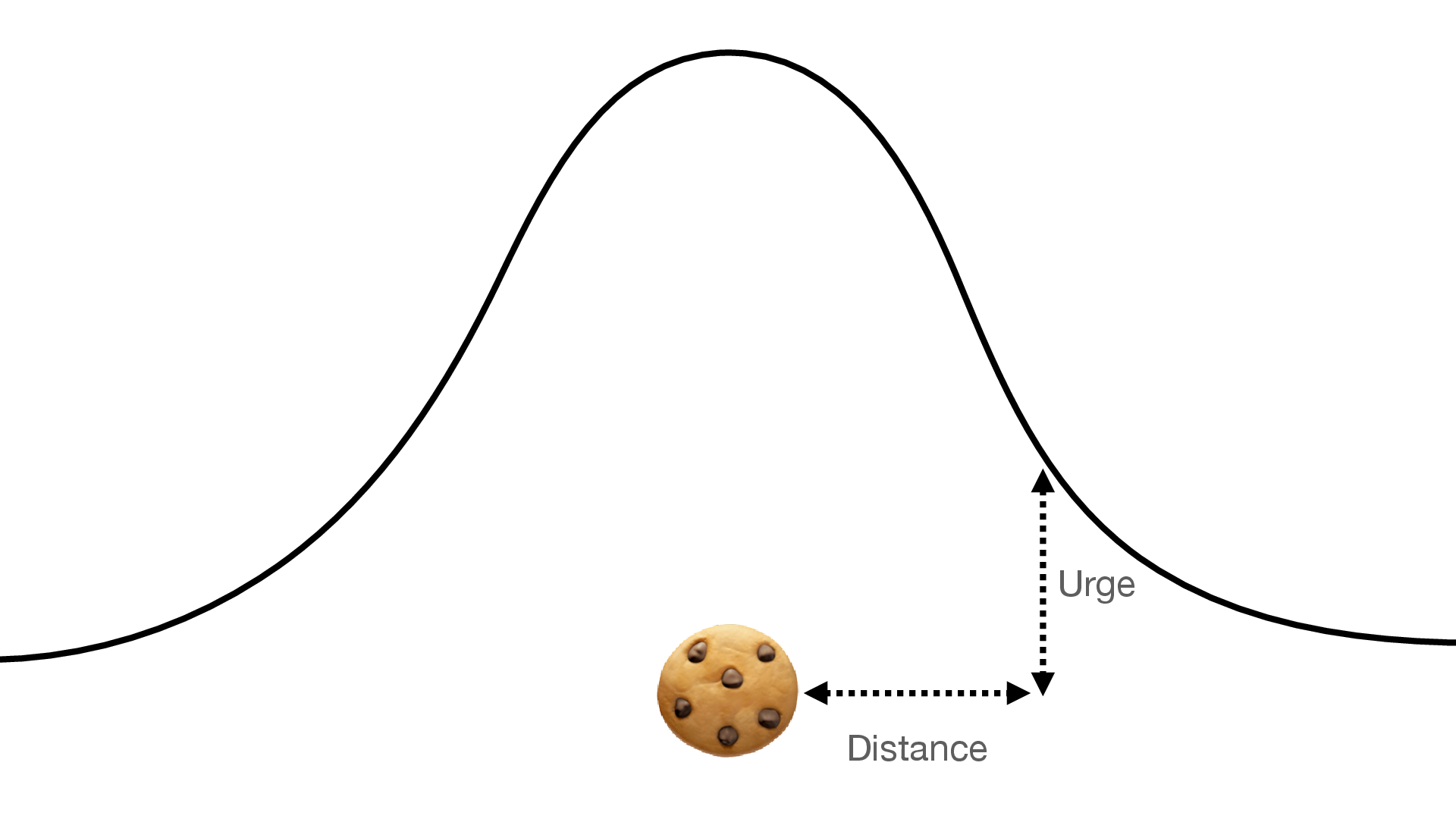
“Object of temptation” could be either a physical object or a tempting behavior.
Defining distance
“Distance” in the sense of temptation could be physical.
Or, distance could be psychological.
A more practical way to think of distance is the expected effort from pursuit of the temptation.
If it feels like it will take a lot of effort to obtain the object of temptation – or the probability of success is low – then it is, psychologically, further away.
On a practical note, increasing distance through effort (rather than distance in space) is generally easier.
Self-locking cookie jars and phone cages that limit access during set times can be effective ways to mute temptation fields with this strategy.
On digital devices, effort may be the most practical way to manipulate “distance,” since these devices are almost always with us.
For example, you can put your most tempting apps in sub-folders on the last screen, so it takes more effort to open them.
Physical distance works of course too. For instance, you can plug your phone at sufficient distance from the bed to reduce the urge to stay up late at night on your phone. (As a bonus, having to physically get up and out of bed to turn off your alarm makes it much more likely you’ll stay up once you’re up.)
Examples of temptation fields
Once you learn to recognize temptation fields, you’ll see them everywhere:
A jar of cookies on the table is a temptation field.
Advertisements are temptation fields.
Web sites like amazon.com bombard you with temptation fields.
Each social media app induces a temptation field.
Any addictive substance or behavior induces a temptation field.
Couches and beds are temptation fields.
A TV is a temptation field.
Temptation versus willpower
Your willpower is your capacity to resist an urge or override an aversion, and you can plot the upper limit of willpower against a temptation field:
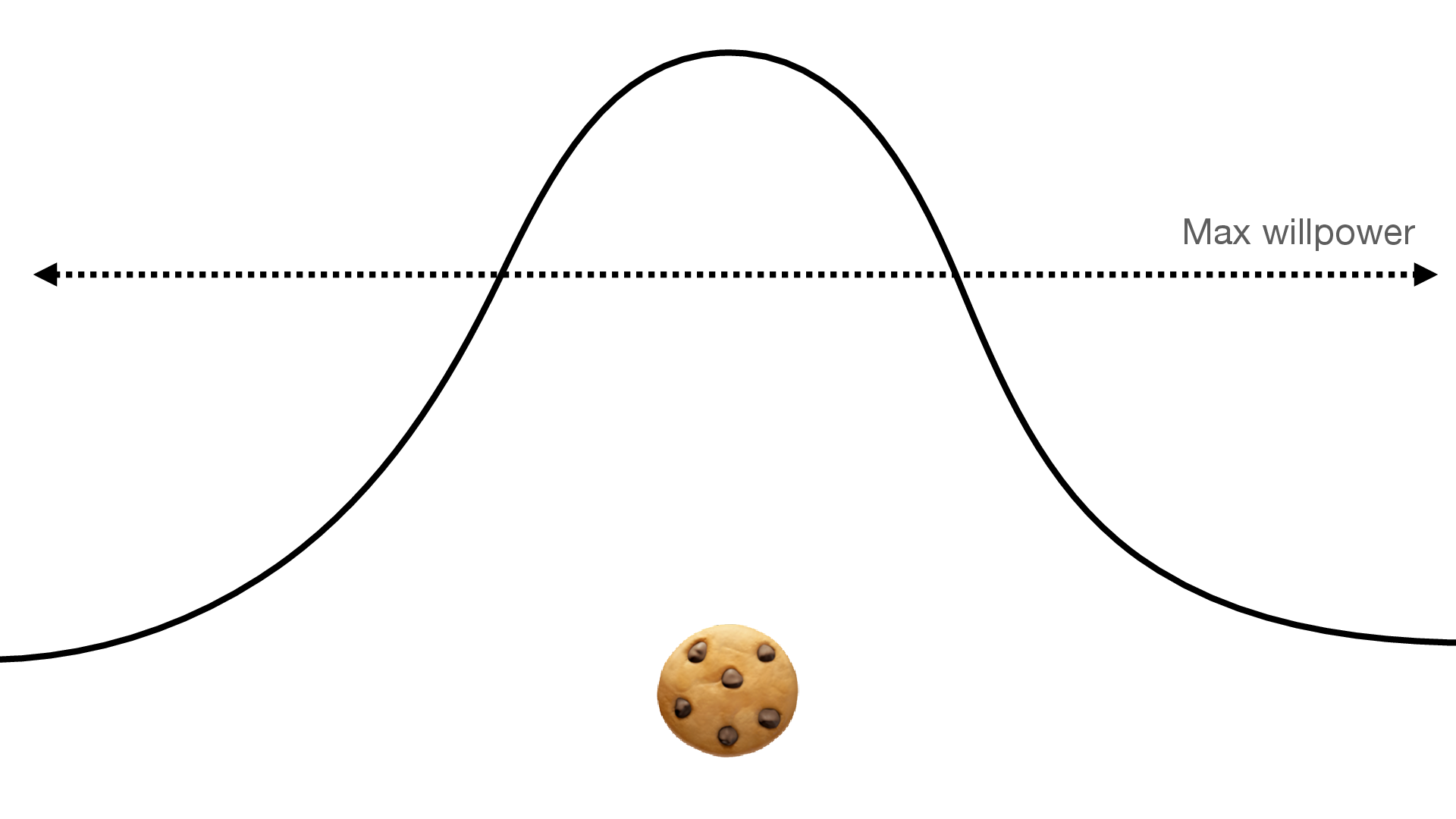
This upper limit on willpower is what creates the “zone of akrasia.”
The zone of akrasia
The zone of akrasia exists at some distance from an object of temptation, bounded by the intersection of urge and willpower:
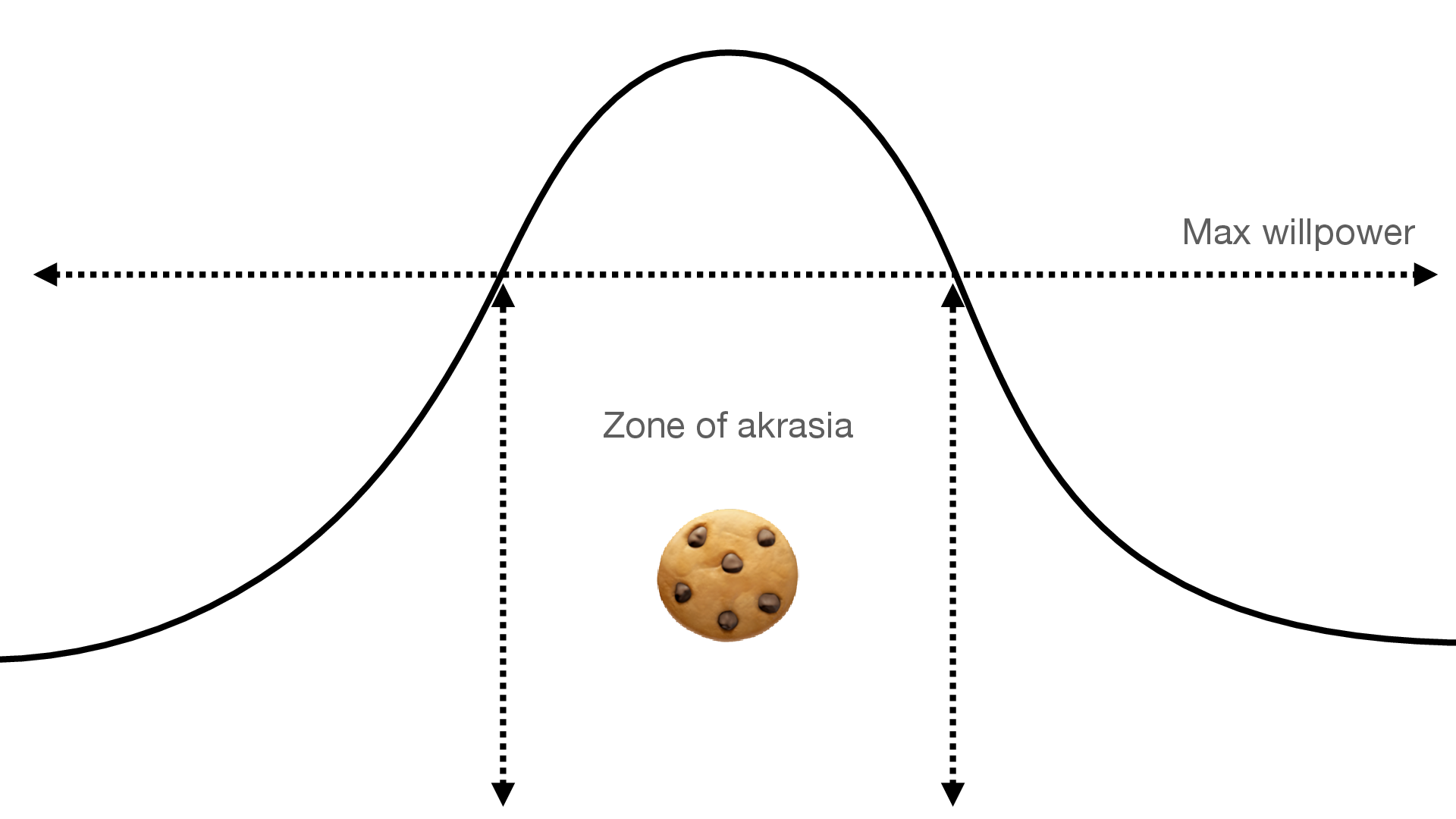
And, outside this akratic zone is the zone of self-control:
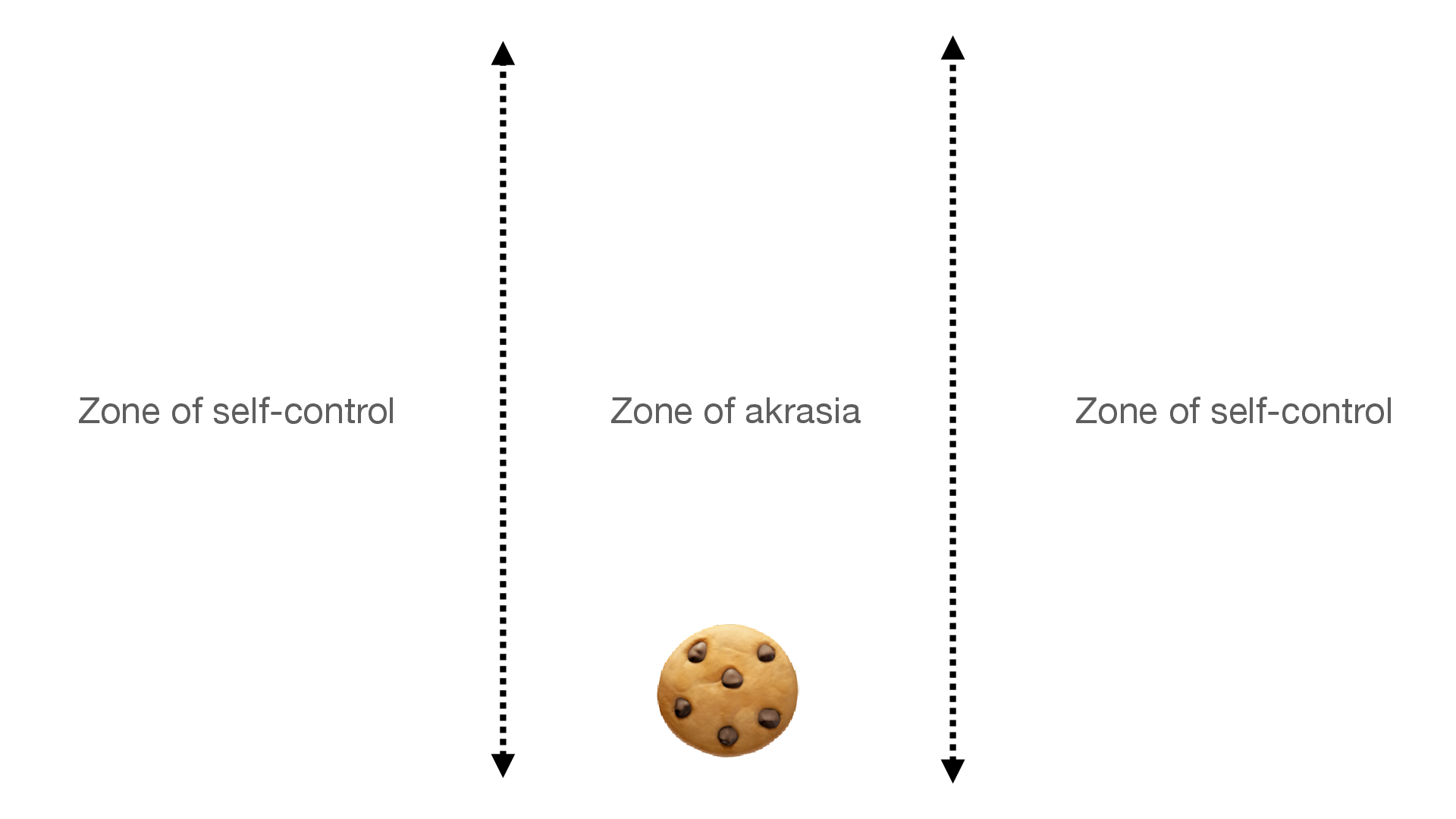
Once inside the zone of akrasia – in this model – you will succumb to temptation, because within this zone, urge is higher than available willpower.
You could imagine the boundary on the zone of akrasia like the event horizon on a black hole: once you’re inside the boundary, there is no way out.
It is your maximum willpower that determines the size of this akratic zone.
As willpower weakens, the zone of akrasia expands.
As willpower strengthens, the zone of akrasia shrinks.
If you are outside the zone of akrasia, you have the willpower to resist.
So, there seem to be two zones within a temptation field – the zone of self-control and the zone of akrasia.
But, this two-zone model oversimplifies the nature of temptation over time.
It doesn’t recognize the invisible danger zone hiding within self-control.
The danger zone
If willpower were constant, then the two-zone model would suffice.
However, there is evidence that using willpower draws from a scarce reserve, steadily diminishing the capacity to exert willpower. (See Baumeister’s review in Willpower for the research.)
I’ve used the term willenergy to describe this reserve when talking about improving self-control.
As willenergy depletes, willpower contracts: the zone of akrasia expands.
So, while you have self-control outside the zone of akrasia, there’s another zone outside the zone of akrasia: the danger zone.
Inside the danger zone, you still have self-control.
However, inside the danger zone, you’re burning up willpower faster than you can replenish it.
As a result, the danger zone is the “zone of eventual akrasia.”
While you are in the danger zone, you can still resist.
But, you cannot stay in the danger zone indefinitely, because inside the danger zone, willpower failure is inevitable: even if you stay still, the zone of akrasia will expand to encompass you.
The boundary of the danger zone is where the willpower needed to resist meets the rate at which willenergy is being regenerated:
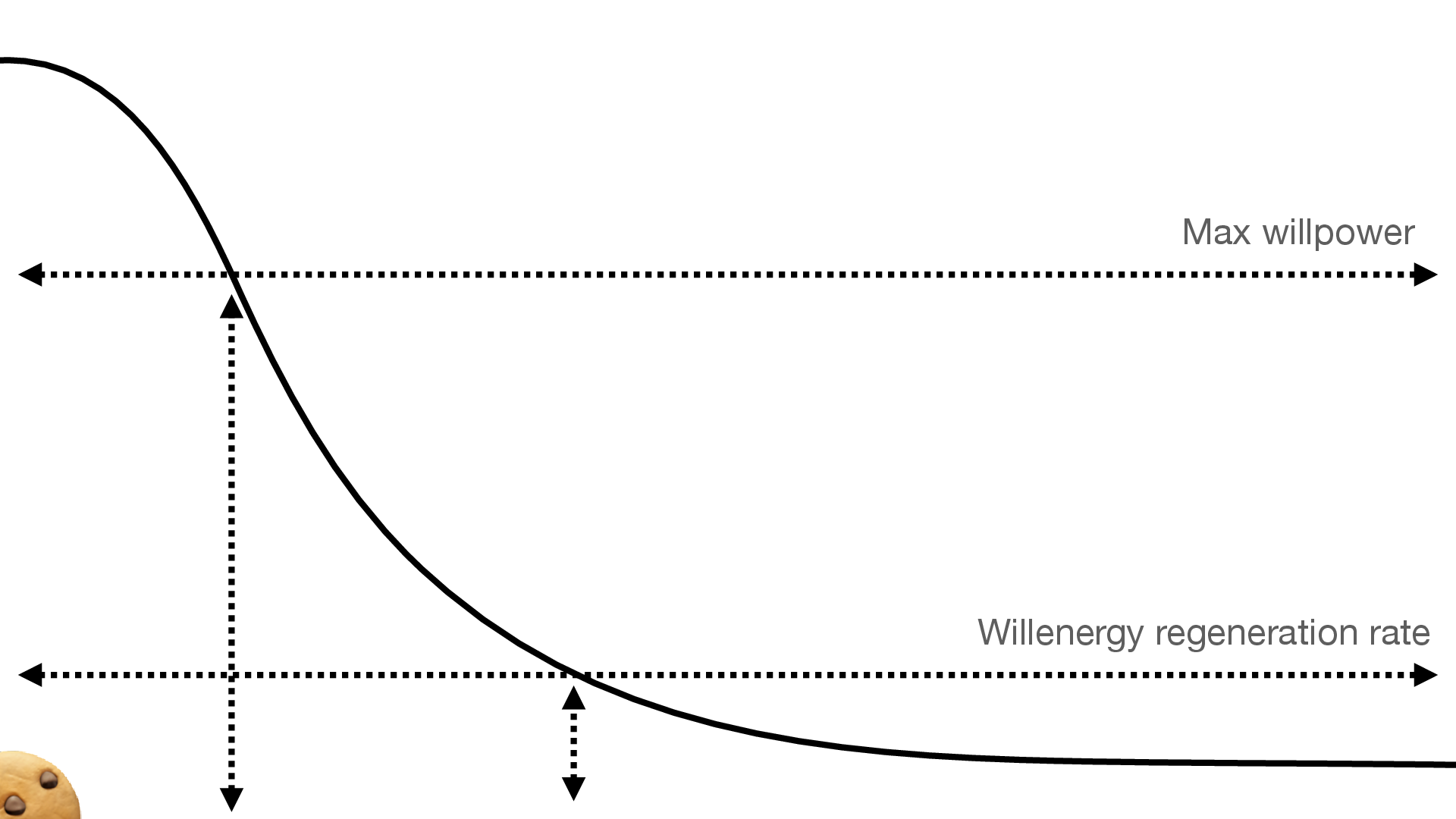
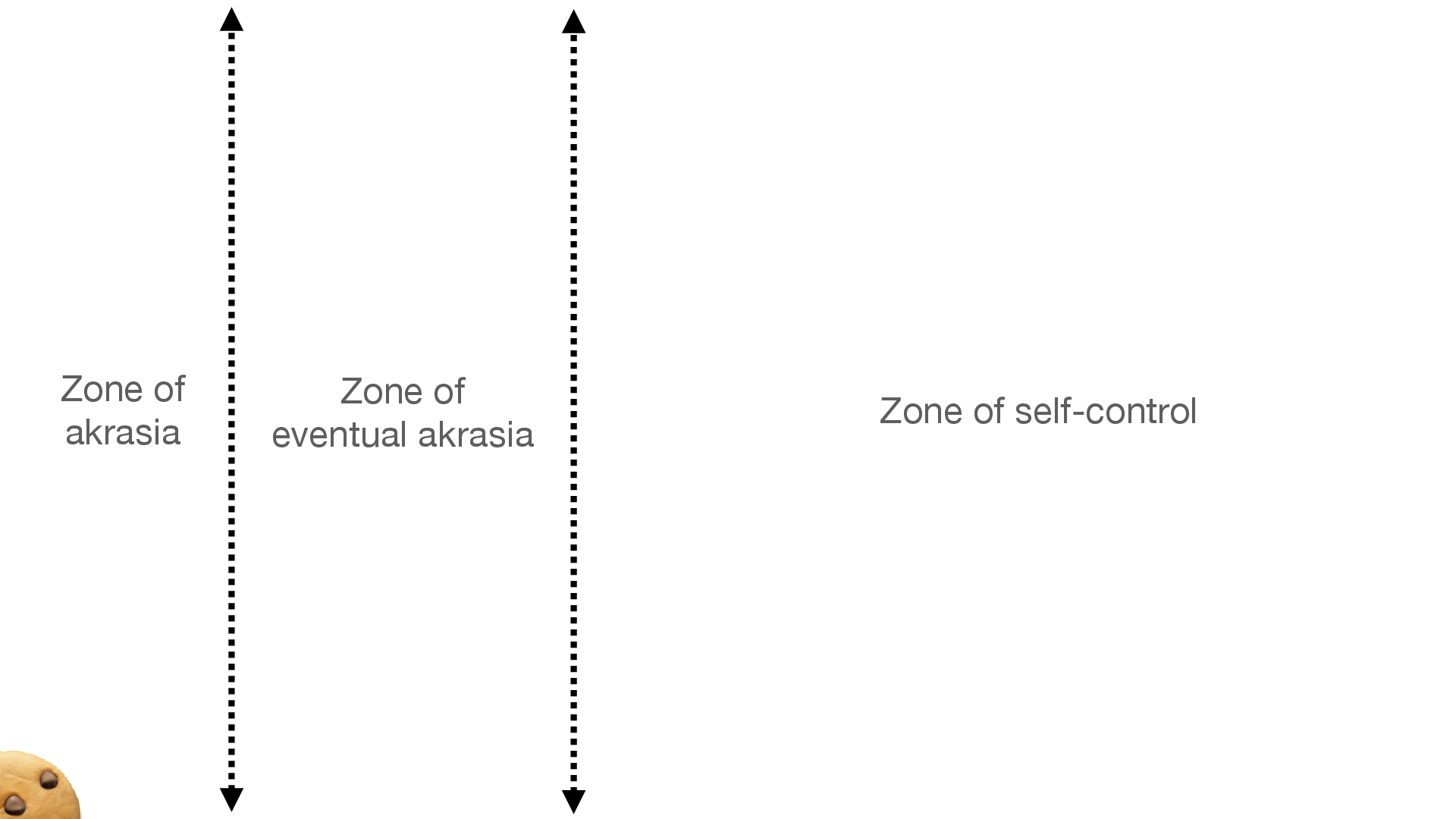
How the danger zone causes overconfidence
If you enter and exit the danger zone repeatedly, you will start to build up a false sense of confidence, because you have repeatedly resisted temptation.
Eventually, you will make the mistake of assuming that because you’ve been in the danger zone before and successfully resisted the pull, you can stay in the danger zone or come and go as you please.
Human brains are inductive reasoning engines, so it’s very easy for a brain to make an inference of the form, “I resisted the temptation successfully five times. Therefore, I will always be able to resist the temptation.”
Of course, the brain is wrong.
While you may have enough willpower to resist temptation at first – or five times – the more time you spend there, the higher the risk you will be enveloped by that ever-expanding zone of akrasia.
No matter how many times you’ve entered and exited the danger zone successfully in the past, the next time may well be the one where you slip and land the zone of akrasia.
How to avoid temptation
To avoid temptation in the long term, you have to put so much distance between you and the object of desire that you land outside the danger zone.
You should be able to “feel” the boundary of the danger zone, because you should feel your capacity to resist falling.
The time to act is not once you’ve lost the capacity resist – because by then you can’t act.
The time to act is when you realize you’ve entered the danger zone – when you feel willpower weakening.
How to break out of the akratic zone
If you do find yourself trapped inside the zone of akrasia, the only way out is to provoke a sudden surge in available willpower.
It’s not impossible to do this, but it’s not a sustainable strategy either.
I’ve written about willpower (and willenergy) hacks previously.
In Willpower, Baumeister looks at how to jolt willpower as well.
For example, eating a cookie might give you a short-acting bolus of willpower – although that’s not particularly helpful if you’re attempting to use willpower to avoid eating a cookie.
How to avoid resisting temptation
The key lesson of combining temptation fields and willpower into one model is that it’s not enough to avoid an object of temptation.
You have to avoid the unsustainable regions in its temptation field.
You have to avoid the need to resist.
Fortunately, you can modify lifestyle and environment to shrink the danger zone to manageable levels in many cases.
If you’re thoughtful, you may even be able to eliminate many temptation fields – or stop creating them in the first-place.
For example, if you’re dieting, when you see something at the grocery store, ask if it’s going to induce a temptation field once you have it back home.
Hacking temptation: Increase distance
The most obvious way to manage temptation is to put distance (in any sense) between yourself and the object of temptation.
While distance can be physical distance, increasing the effort required to get to an object of temptation increases the effective distance as well.
Placing objects in inconvenient places (high shelves, hard to reach attics) mutes the temptation field.
Putting objects behind time-consuming locks mutes the temptation field.
Even better still is to not have objects of temptation in your environment at all.
Hacking temptation: Recognize faltering willpower
A challenge in managing temptation is training yourself to be aware of diminishing willpower – of your presence in the danger zone.
You can enhance this introspective awareness with mindfulness training such as meditation.
If you are not familiar with meditation or mindfulness training, I recommend both the Waking Up and Headspace apps as complementary approaches to the practice.
The other reason it’s hard to recognize the danger zone is because it often feels good to be in it.
After all, being tempted can be a pleasurable and exciting state.
As a result, your primary feeling might be a sense of impending reward, which overshadows the feeling that self-control is slipping away.
Hacking temptation: Cripple technology
I have an article on how crippling your technology can boost productivity.
For example, when you feel yourself get pulled into browsing social media, you could use that as your cue to activate an app like Self Control.
Or, if you find that at certain times of the day you are regularly giving in, try scheduling restrictive apps and bans to start automatically at these times.
Years ago, I even took the step of having my router shut down my internet every night because I was tempted to browse social media and answer emails so late into the night that it was harming my sleep.
In retrospect, I realize the reason many of those techniques work is that they mute or destroy temptation fields.
The work/play strategy
Taking this approach to an extreme, all of my digital devices are now cleanly partitioned into “work” devices and “play” devices.
For example, my laptop and my phone are “work” devices that have no access to news sites, to games or to social media.
Blocking temptations entirely on “work” devices removes the risk of flipping over to them if the “play” devices are kept at sufficient distance.
When I’m on a work device, all I can do is work.
But, my “play” devices – an iPad and a fixed-location desktop gaming computer – have access to distracting temptations.
Getting to these objects requires going up a flight of stairs – just enough of a barrier to prevent expending willpower on resisting them.
Example: The George R.R. Martin approach
The writer George R.R. Martin of Game of Thrones fame takes this work/play strategy to an extreme.
His “work” computer is an old DOS machine running WordStar 4.0.
It has no internet and no multi-tasking.
It is all but useless for anything but writing.
Hacking temptation: Failure journaling
It may take time before meditation delivers enough mindfulness to regularly recognize crossing the boundary into the danger zone.
And, even with significant mindfulness training, there will still be times when you slip across that boundary without the mental alarm going off in time.
The most effective way of reducing temptation over time is to journal your failures.
You can make a practice of rewinding your mental state every time you succumb to temptation.
Try to remember how it felt before you gave in to temptation – both right before, but also minutes, hours or days before:
When did you cross into the danger zone?
When did you cross into the zone of akrasia?
What were the steps that led up to each?
Journal how it happened for every surrender to temptation.
Journal how it felt after.
Look for the patterns emerging.
Then, brainstorm changes to lifestyle, environment or habit that might prevent a recurrence.
Most of these will in some way involve muting, moving or destroying temptation fields.
For example, if you keep eating the snacks on the counter when you walk by, keep the snacks in the pantry.
If you still keep eating them, move them to a higher shelf in the pantry.
If you still can’t stop eating them, throw them out – and don’t buy them again.
Try out a change with each failure, and wait to see if you succumb to the same temptation again.
More reading
If you’re interested in the topic of self-control and behavior, you might also be interested in my article on self-control, which looks at willpower from the perspective of optimizing the use of your willpower and the scare resource underpinning it.
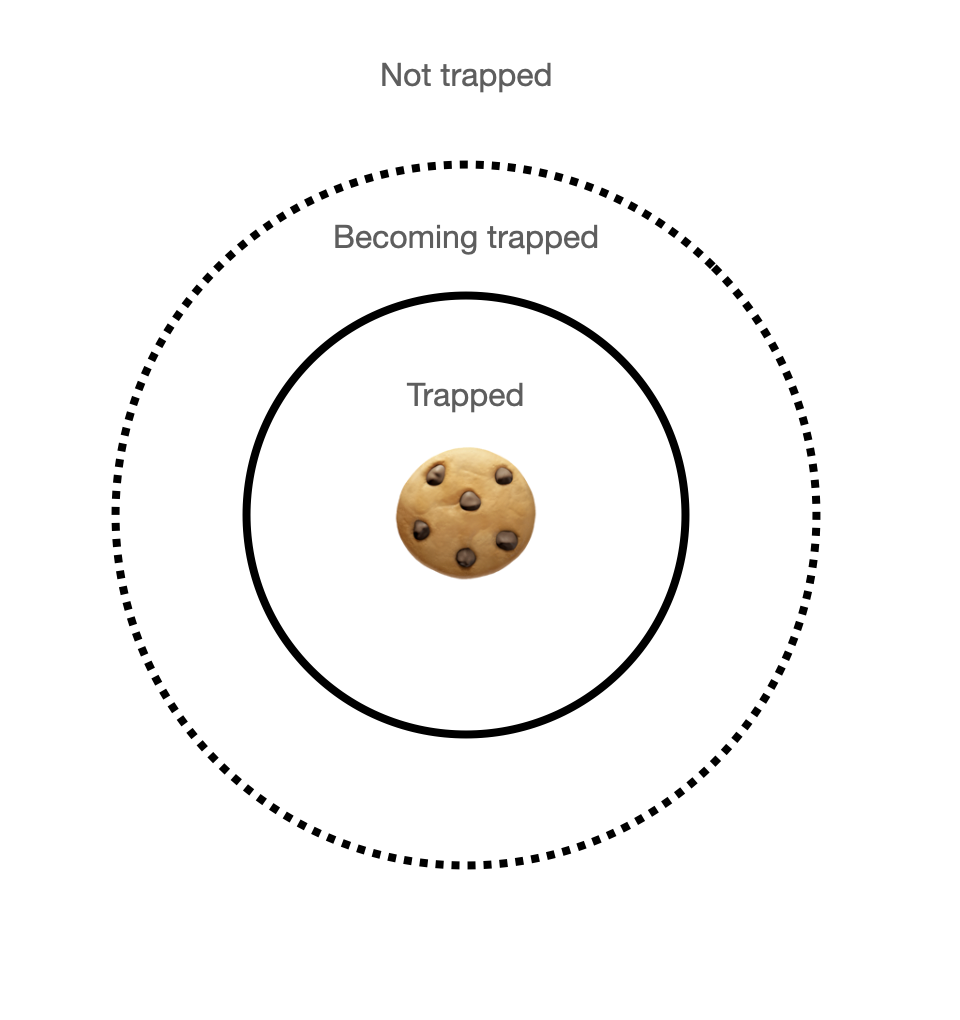
Twitter: @mattmight
Instagram: @mattmight
LinkedIn: matthewmight
Mastodon: @mattmight@mathstodon.xyz
Sub-reddit: /r/mattmight